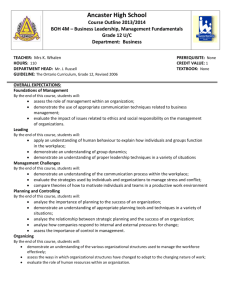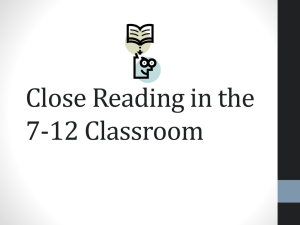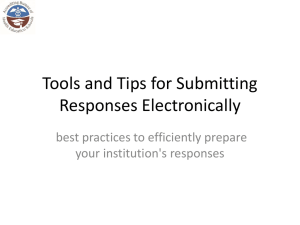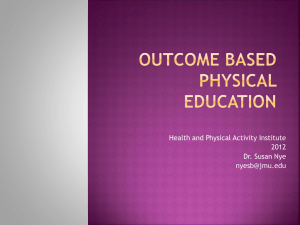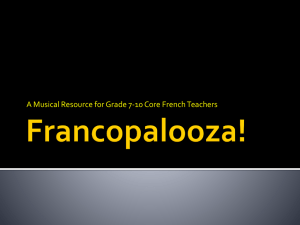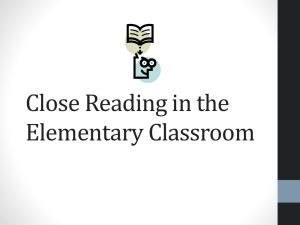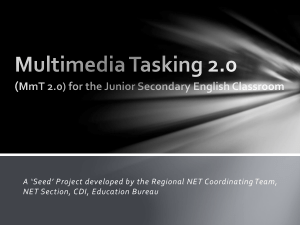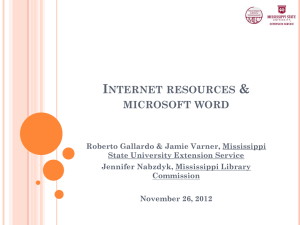Mosaic of Thought Reading Strategies
advertisement
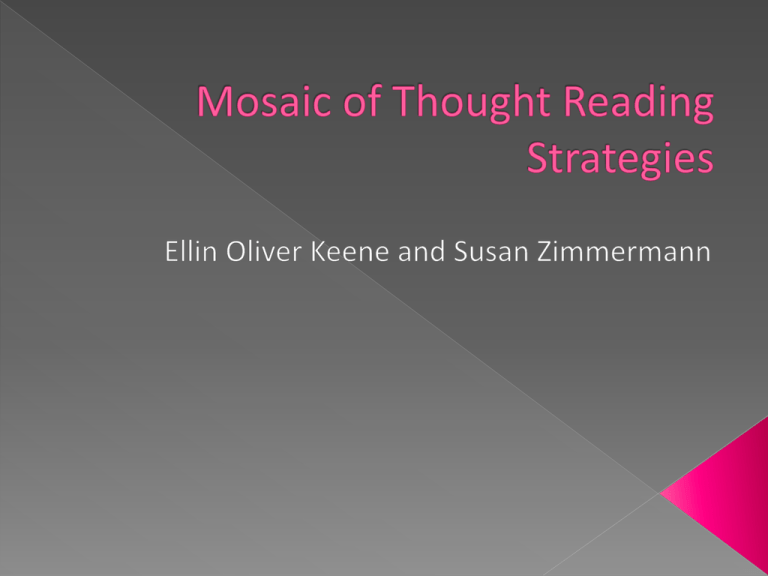
How do I know if my students are understanding what they are reading? Monitoring for Meaning is an umbrella strategy that helps the teacher answer the following: Are students understanding what they are reading? Do they know when they have lost meaning? Think-pair share: Sharing during literacy circles Ask two before me Vocabulary activities for challenging words during the reading. Writing prompts Our students need to know that their questions matter. They need to see us asking questions as well as answering them. Asking questions engages us and keeps us reading. A reader with no questions might just as well abandon the book. Q- chart Questioning bookmark Discussion questions Create their own chapter review questions Create discussion questions for their classmates Prior knowledge (in the form of schemata) influences our comprehension to a much greater degree than earlier research would have suggested... So powerful is the influence of prior knowledge on comprehension that Johnson and Pearson have found that prior knowledge of topic is a better predictor of comprehension than is either intelligence test score or reading achievement test score." Since prior knowledge is essential for the comprehension of new information, it is important to make sure that you establish concrete connections to new topics of study for your students. KWL Chart: Things I KNOW, WANT to know, things I LEARNED before Reader response and bookmarks: How is the character or action related to me? Text to self, text to text, text to world charts Being able to figure out what is important in a given text is an essential skill for students to learn, especially when dealing with the content-dense nonfiction. Word Level –eyes focus longer on words that carry the weight of the meaning Sentence Level- repetition, text features (bold print, italics, graphs, figures, photographs) and longer passages Whole –Text or Idea Level- Overall meaning of text (after passing the other two levels) We can help student focus in on central ideas by: “Getting to know your textbook” activity KWL chart Key word chart Note taking template Important events bookmark Helping students create mental images as they read can help them better comprehend the content of the text and remember it longer. As Keene and Zimmerman say in Mosaic of Thought, "Proficient readers use images to draw conclusions, to create distinct and unique interpretations of the text, to recall details significant to the text, and to recall a text after it has been read." When students combine their background knowledge with the pictures they have generated from descriptive prose, they put themselves into the book and bring the words to life. When students turn abstract concepts such as size, weight, length, distance and time into concrete pictures, they come to a better understanding of these concepts. Mental image title pages, covers, and posters Setting description and drawing worksheet Character traits worksheet Inferring is "reading between the lines," going beyond the literal meaning in a text. It requires the reader to make a connection between what is on the page and relevant prior knowledge. Picture walks Using context clues to infer: bookmarks Reader response In their study guide for Strategies that Work, Stephanie Harvey explain: "Synthesizing involves combining new information with existing knowledge to form an original idea or interpretation. Synthesizing lies on a continuum." Summary worksheets Important events bookmarks Reader response worksheets "This book is an invitation to the reading dance and shows you how to do the steps effectively.” “This book takes the best of reading comprehension research and shows us how to actively apply it to our own reading and how to help children do the same." THANK YOU!!! Literature Circles Literature study provides opportunities to discuss how authors create and craft quality literature. By choosing the literature and by recording their responses and insights as they read, students take ownership of their learning. They participate in reflective discussions about literature within supportive group environments. Purposes: to develop personal responses to a text to experience peer sharing of understandings, interpretations, and comments about a text to extend students' comprehension of literary selections to involve students in discussion, negotiation, compromise and decisionmaking in a group setting to develop appreciation of authors' styles to develop good reading strategies Duration: 4-5 weeks (every grading period) Folder Assigned novels (according to last lexile) Contracts (signed by parents) Guided detailed instructions ( worksheets: title page, character traits, setting, vocabulary, Summary, and prompt with reflection/self evaluation ) Rubrics: folder and culminating activity Mini strategy lessons (character traits) Assigned group culminating activity (Act out a favorite scene of the novel) Formal Assessment for novels and poster Notebook Assigned novels (according to their last lexile) Guided instructions (worksheet: instructions for bookmarks, reading tasks, culminating activity, section division, journal, team evaluation, and due dates.) Bookmarks: characters, questions, vocabulary, and plot (one bookmark for each section) Rubrics for notebook and culminating activity Mini strategy lesson (questioning-use chart) Assigned group culminating activity ( 3D model of their favorite scene with a written description and oral presentation) Assessment: Book Jacket Notebook Assigned novels (according to their last lexile) Guided instructions (worksheet: instructions for bookmarks, reading tasks, section division, role descriptions and charts, journal, team evaluation by director, and due dates) Bookmarks: character traits, questions, vocabulary, important events, vocabulary, and connections (one bookmark for each section) Rubrics for notebook and culminating activity Mini strategy lesson (making connections) Assigned group culminating activity (comic strip with oral presentation) Assessment: booklet on Publisher (cover, characters/settings, plot and summary, and closure paragraph-opinion, relation, and recommendation) Notebook Students choose among the books available. Lexile groups vote and agree Guided instructions (worksheet: instructions for bookmarks, reading tasks, section division, role descriptions and charts, journal, team evaluation by director, and due dates) Bookmarks: character traits with evidence, questions, plot sequence, inferences, setting, and reflection Rubrics for notebook and culminating activity Mini strategy lesson (inference-use chart) Assigned group culminating activity (Life size character model with novel knowledge. Assessment: Cereal Box Book Report Notebook Students fill out choice ballots with three favorite. Assign groups with students from all three classrooms Assign novels to mixed groups. Guided instructions (worksheet: instructions for bookmarks, reading tasks, section division, role descriptions and charts, journal, team evaluation by director, and due dates) Bookmarks: character traits with evidence, setting (including mood), major events, connections, and conflicts Rubrics for notebook and culminating activity Mini strategy lesson (conflicts, climax and synthesizing the summary) Assigned group culminating activity (ATS Live show with characters from the novel) Assessment: Formal 4 paragraph book report
